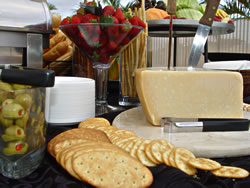Returning Students
You may also like:
Most Recent:
- GMP- Good Manufacturing Processes for food 2010.10.28 Good Manufacturing Processes for food
- HACCP Principle 4 - Establish Monitoring Procedures 2009.09.21 HACCP Principle 4 - Establish Monitoring Procedures
- HACCP Certification Training Home 2009.09.21 HACCP Certification Training Online
Approved Course

Applying HACCP Principles™ For The Food Service Industry has been Reviewed and Accredited by the HACCP Alliance as meeting the required standards for content and training for introductory HACCP.
Bookmarks & Feeds
News:
HACCP Wireless Refrigeration Monitoring System
HACCP Wireless Refrigeration Monitoring System requires no PC or software
How to Implement a HACCP Food Safety Program in Your Restaurant - Principle 1
Articles » HACCP Principle 1- How to Implement a Food Safety Program in Your Restaurant
By Gregory Scott McGuire
The Hazard Analysis and Critical Control Point (HACCP) program is not a requirement for the food service industry. Developed 30 years ago by NASA to manage food safety in space, HACCP has since become the definitive FDA program for controlling food-borne illnesses. HACCP is effective because it requires the commercial kitchen to identify and then track the points where food is exposed to agents that can cause illness. Many local boards of health promote the use of HACCP because it is so effective in controlling outbreaks and illness, but again, it is not a required program.

So why use HACCP if it's not required? Because making even one customer sick can spell lawsuits and financial ruin for your business. Large institutions that serve thousands of meals a day like prisons and universities practice HACCP religiously for this very reason. Small independent operators and small, medium, and large chains face no less amount of risk from food-borne illness, and yet many do not use a HACCP program to control food risks. The purpose of HACCP is to give you active managerial control over the most critical points relating to food safety in your establishment.
Principle 1 - Understanding Hazards and Risk Factors
This step is also the first part of the HACCP acronym: Hazard Analysis. The second part, Critical Control Points, doesn't do you much good if you don't know which hazards to control. Food-borne illnesses originate from three primary groups of hazards:
Biological agents: bacteria and bacteria-produced toxins, parasites, and viruses.
Physical objects: jewelry, stones, glass, bone and metal fragments, and packaging materials.
Chemical contamination: allergens, cleaning compounds, food additives, insecticides
Food-borne illnesses can result from all three of these groups, although the most common, and most worrisome for restaurateurs, is biological contamination. All three groups can be controlled using an effective HACCP program. So how do these hazards actually get transmitted to food being prepared and served in restaurants?
Here are the primary risk factors:
- Food from unsafe sources. The restaurant is only one link in a long chain that brings food from the place it was harvested to the diner's table. Unfortunately for restaurants, they are the last link in that chain. That means they stand to take the blame for food-borne illnesses.
- Inadequate cooking. Unlike unsafe sources, restaurants absolutely can and should control how food is cooked.
- Improper holding temperatures. Raw food and cooked food both need to be stored at the proper temperature (below 41 degrees Fahrenheit) in order to prevent biological agents from spreading.
- Contaminated equipment. The equipment used in a commercial kitchen can easily transfer any of the three groups of hazards listed above to food just before it is served to a customer.
- Poor personal hygiene. Likewise, restaurant staff can easily transfer any of the three hazard groups to food at the most critical time.
The most common ways to address the above hazards are:
- Only buy food product from a reliable, approved source. Also ensure proper and safe handling once food arrives at your restaurant.
- Always cook food thoroughly. Make sure uncooked products you buy like dairy and juice have been pasteurized or thermally processed.
- Make sure food is at the proper temperature when you are hot holding, cold holding, cooking, or freezing it. Also date mark food product and follow a First In, First Out (FIFO) strategy that ensures the oldest product is used first.
Every restaurant encounters these risk factors. To conduct a hazard analysis in your establishment, carefully evaluate where, when, why, and how each of the above factors occurs, and which of the three types of hazards are involved. Once you have a complete list of hazards and risks, you can start to develop a process for addressing and minimizing those problems.
Gregory Scott McGuire is a regular contributor to The Back Burner Blog, a resource of restaurant news and trends written by the employees of Tundra Specialties, a company specializing in restaurant equipment, supplies, and equipment parts.